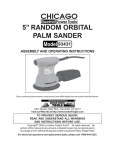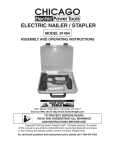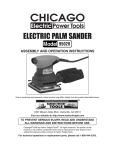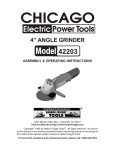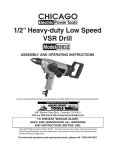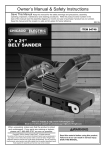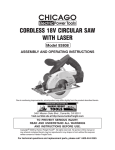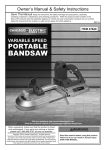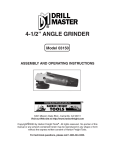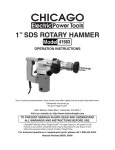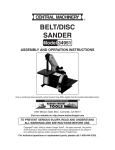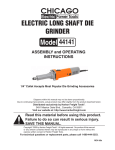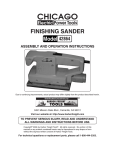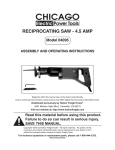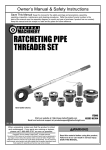Download Harbor Freight Tools 46055 User's Manual
Transcript
VARIABLE SPEED JIGSAW Model 46055 ASSEMBLY and OPERATING INSTRUCTIONS 3491 Mission Oaks Blvd., Camarillo, CA 93011 Visit our Web site at http://www.harborfreight.com TO PREVENT SERIOUS INJURY, READ AND UNDERSTAND ALL WARNINGS AND INSTRUCTIONS BEFORE USE. Copyright© 2001, 2004 by Harbor Freight Tools®. All rights reserved. No portion of this manual or any artwork contained herein may be reproduced in any shape or form without the express written consent of Harbor Freight Tools. For technical questions and replacement parts, please call 1-800-444-3353 Specifications Double Insulated Motor 3.5 Amps, 120 V / 60 Hz / Single Phase Variable Speed Range 500-3000 SPM, Six Speed Settings Maximum Cutting Depth 2-1/8 inch Stroke 3/4 inch Cord 18 Gauge, Two Prong Includes 6 TPI and 24 TPI Blades and Tiltable Base (TPI = Teeth per Inch) This Jigsaw uses Universal (U) Shank Blades. Replacement Blade ITEM #: 02713 - 14 Pc. Jigsaw Blade Set. E194601 Save This Manual You will need the manual for the safety warnings and precautions, assembly instructions, operating and maintenance procedures, parts list and diagram. Keep your invoice with this manual. Write the invoice number on the inside of the front cover. Keep the manual and invoice in a safe and dry place for future reference. General Safety Rules WARNING! READ AND UNDERSTAND ALL INSTRUCTIONS Failure to follow all instructions listed below may result in electric shock, fire, and/or serious injury. SAVE THESE INSTRUCTIONS Work Area 1. Keep your work area clean and well lit. Cluttered benches and dark areas invite accidents. 2. Do not operate power tools in explosive atmospheres, such as in the presence of flammable liquids, gases, or dust. Power tools create sparks which may ignite the dust or fumes. 3. Keep bystanders, children, and visitors away while operating a power tool. Distractions can cause you to lose control. Protect others in the work area from debris such as chips and sparks. Provide barriers or shields as needed. Electrical Safety 4. Grounded tools must be plugged into an outlet properly installed and grounded in accordance with all codes and ordinances. Never remove the grounding prong or modify the plug in any way. Do not use any adapter plugs. Check with a qualified electrician if you are in doubt as to whether the outlet is properly grounded. If the tools should electrically malfunction or break down, grounding provides a low resistance path to carry electricity away from the user. Page 2 REV 02/05 SKU 46055 5. Double insulated tools are equipped with a polarized plug (one blade is wider than the other). This plug will fit in a polarized outlet only one way. If the plug does not fit fully in the outlet, reverse the plug. If it still does not fit, contact a qualified electrician to install a polarized outlet. Do not change the plug in any way. Double insulation eliminates the need for the three wire grounded power cord and grounded power supply system. 6. Avoid body contact with grounded surfaces such as pipes, radiators, ranges, and refrigerators. There is an increased risk of electric shock if your body is grounded. 7. Do not expose power tools to rain or wet conditions. Water entering a power tool will increase the risk of electric shock. 8. Do not abuse the Power Cord. Never use the Power Cord to carry the tools or pull the Plug from an outlet. Keep the Power Cord away from heat, oil, sharp edges, or moving parts. Replace damaged Power Cords immediately. Damaged Power Cords increase the risk of electric shock. 9. When operating a power tool outside, use an outdoor extension cord marked “W-A” or “W”. These extension cords are rated for outdoor use, and reduce the risk of electric shock. Personal Safety 10. Stay alert. Watch what you are doing, and use common sense when operating a power tool. Do not use a power tool while tired or under the influence of drugs, alcohol, or medication. A moment of inattention while operating power tools may result in serious personal injury. 11. Dress properly. Do not wear loose clothing or jewelry. Contain long hair. Keep your hair, clothing, and gloves away from moving parts. Loose clothes, jewelry, or long hair can be caught in moving parts. 12. Avoid accidental starting. Be sure the Power Switch is off before plugging in. Carrying power tools with your finger on the Power Switch, or plugging in power tools with the Power Switch on, invites accidents. 13. Remove adjusting keys or wrenches before turning the power tool on. A wrench or a key that is left attached to a rotating part of the power tool may result in personal injury. 14. Do not overreach. Keep proper footing and balance at all times. Proper footing and balance enables better control of the power tool in unexpected situations. 15. Use safety equipment. Always wear eye protection. Dust mask, nonskid safety shoes, hard hat, or hearing protection must also be used for appropriate conditions. SKU 46055 Page 3 Tool Use and Care 16. Use clamps (not included) or other practical ways to secure and support the workpiece to a stable platform. Holding the work by hand or against your body is unstable and may lead to loss of control. 17. Do not force the tool. Use the correct tool for your application. The correct tool will do the job better and safer at the rate for which it is designed. 18. Do not use the power tool if the Power Switch does not turn it on or off. Any tool that cannot be controlled with the Power Switch is dangerous and must be replaced. 19. Disconnect the Power Cord Plug from the power source before making any adjustments, changing accessories, or storing the tool. Such preventive safety measures reduce the risk of starting the tool accidentally. 20. Store idle tools out of reach of children and other untrained persons. Tools are dangerous in the hands of untrained users. 21. Maintain tools with care. Keep cutting tools sharp and clean. Properly maintained tools with a sharp cutting edge are less likely to bind and are easier to control. Do not use a damaged tool. Tag damaged tools “Do not use” until repaired. 22. Check for misalignment or binding of moving parts, breakage of parts, and any other condition that may affect the tool’s operation. If damaged, have the tool serviced before using. Many accidents are caused by poorly maintained tools. 23. Use only accessories that are recommended by the manufacturer for your model. Accessories that may be suitable for one tool may become hazardous when used on another tool. Service 24. Tool service must be performed only by qualified repair personnel. Service or maintenance performed by unqualified personnel could result in a risk of injury. 25. When servicing a tool, use only identical replacement parts. Follow instructions in the “Maintenance” section of this manual. Use of unauthorized parts or failure to follow maintenance instructions may create a risk of electric shock or injury. Note: Performance of this tool (if powered by line voltage) may vary depending on variations in local line voltage. Extension cord usage may also affect tool performance. Warning: The warnings, cautions and instructions discussed in this instruction manual cannot cover all possible conditions and situations that may occur. It must be understood by the operator that common sense and caution are factors which cannot be built into this product, but must be supplied by the operator. SKU 46055 Page 4 Jigsaw Specific Safety Rules 1. Hold the tool by insulated gripping surfaces when performing an operation where the cutting tool may contact hidden wiring or its own cord. Contact with a ‘live’ wire will make exposed metal parts of the tool ‘live’ and shock the operator. 2. WARNING! Some dust created by power sanding, sawing, grinding, drilling, and other construction activities, contain chemicals known (to the State of California) to cause cancer, birth defects or other reproductive harm. Some examples of these chemicals are: lead from lead-based paints, crystalline silica from bricks and cement or other masonry products, arsenic and chromium from chemically treated lumber. Your risk from these exposures varies, depending on how often you do this type of work. To reduce your exposure to these chemicals: work in a well ventilated area, and work with approved safety equipment, such as those dust masks that are specially designed to filter out microscopic particles. (California Health & Safety Code 25249.5, et seq.) 3. WARNING! People with pacemakers should consult their physician(s) before using this product. Operation of electrical equipment in close proximity to a heart pacemaker could cause interference or failure of the pacemaker. GROUNDING WARNING! Improperly connecting the grounding wire can result in the risk of electric shock. Check with a qualified electrician if you are in doubt as to whether the outlet is properly grounded. Do not modify the power cord plug provided with the tool. Never remove the grounding prong from the plug. Do not use the tool if the power cord or plug is damaged. If damaged, have it repaired by a service facility before use. If the plug will not fit the outlet, have a proper outlet installed by a qualified electrician. GROUNDED TOOLS: TOOLS WITH THREE PRONG PLUGS 1. 2. Tools marked with “Grounding Required” have a three wire cord and three prong grounding plug. The plug must be connected to a properly grounded outlet. If the tool should electrically malfunction or break down, grounding provides a low resistance path to carry electricity away from the user, reducing the risk of electric shock. (See Figure A, next page.) The grounding prong in the plug is connected through the green wire inside the cord to the grounding system in the tool. The green wire in the cord must be the only wire connected to the tool’s grounding system and must never be attached to an electrically “live” terminal. (See Figure A.) Page 5 Continued on page 6 SKU 46055 3. Your tool must be plugged into an appropriate outlet, properly installed and grounded in accordance with all codes and ordinances. The plug and outlet should look like those in the following illustration. (See Figure A.) FIGURE A DOUBLE INSULATED TOOLS: TOOLS WITH TWO PRONG PLUGS 4. Tools marked “Double Insulated” do not require grounding. They have a special double insulation system which satisfies OSHA requirements and complies with the applicable standards of Underwriters Laboratories, Inc., the Canadian Standard Association, and the National Electrical Code. (See Figure B.) 5. Double insulated tools may be used in either of the 120 volt outlets shown in the following illustration. (See Figure B.) FIGURE B SKU 46055 Page 6 EXTENSION CORDS 1. Grounded tools require a three wire extension cord. 2. As the distance from the supply outlet increases, you must use a heavier gauge extension cord. Using extension cords with inadequately sized wire causes a serious drop in voltage, resulting in loss of power and possible tool damage. (See Figure C.) 3. The smaller the gauge number of the wire, the greater the capacity of the cord. For example, a 14 gauge cord can carry a higher current than a 16 gauge cord. (See Figure C.) 4. If using more than one extension cord to make up the total length, make sure each cord contains at least the minimum wire size required. (See Figure C.) 5. If you are using one extension cord for more than one tool, add the nameplate amperes and use the sum to determine the required minimum cord size. (See Figure C.) 6. If you are using an extension cord outdoors, make sure it is marked with the suffix “W-A” (“W” in Canada) to indicate it is acceptable for outdoor use. 7. Make sure your extension cord is properly wired and in good electrical condition. Always replace a damaged extension cord or have it repaired by a qualified electrician before using it. 8. Protect your extension cords from sharp objects, excessive heat, and damp or wet areas. REQUIRED MINIMUM EXTENSION CORD GAUGE - 110 VOLT NAMEPLATE AMPERES (At Full Load) 6 8 10 12 14 16 18 20 22 24 26 28 30 EXTENSION CORD LENGTH 0-25 FT. 18 16 16 16 14 14 14 12 12 12 10 10 10 25-50 FT. 16 16 14 14 12 12 12 12 10 10 10 10 10 FIGURE C SKU 46055 Page 7 50-100 FT. 14 12 12 10 10 10 8 8 8 8 8 6 6 100-150 FT. 12 10 10 8 8 8 8 6 6 6 6 4 4 SYMBOLOGY Double Insulated Canadian Standards Association Underwriters Laboratories, Inc. V~ A Volts Alternating Current Amperes no xxxx/min. No Load Revolutions per Minute (RPM) Unpacking When unpacking, check to make sure the parts listed on page 12 are included. If any parts are missing or broken, please call Harbor Freight Tools at the number on the cover of this manual as soon as possible. Blade Mounting Warning! Never attempt to mount a blade unless the Jigsaw is unplugged from the power source. 1. Loosen the Bolt on the Blade Clamp (#21) with the Hex Spanner (#32). Refer to Figure 1. 2. Insert the end (with holes) of the Blade between the Blade Stock and the Blade Clamp. Hold the Blade level while tightening the Bolt with the Hex Spanner (#32). Figure 1 Blade Clamp Bolt Note: To remove a Blade, loosen the Bolt and remove Blade. Blade Stock Blade SKU 46055 Page 8 Blade Mounting (Continued) 3. The Ball or guide must be positioned before use. See Figure 2. 4. Using the Hex Spanner (#32), loosen the Bolt on the bottom plate. Refer to Figure 2. 5. Slide the positioner so that the Ball is touching the blade. Make sure you are working with a straight blade. Note: If you are cutting synthetic plate or metal, use a little cutting oil between the Blade and the Ball. More on cutting metal on page 11. Figure 2 Operation 1. Before plugging in Saw, make sure the Switch (#2) operates without sticking. It must spring back to the original position once depressed. Note: Rotate the Speed Control Switch (#1) from 0-6 to increase the speed of the blade. Note: Make sure your workpiece is securely fastened down. 2. Draw a cutting line on your workpiece. 3. Plug in the Saw and turn it on. Wait until the blade achieves maximum speed. 4. Rest the bottom base of the Saw on the workpiece and move the blade forward. Do not push hard. Let the saw work at its own rate. Do not force the blade. See Figure 3. Figure 3 Note: Make sure the bottom base is level with the workpiece, or the blade could break. SKU 46055 Page 9 Operation (continued) Note: Unplug tool before making adjustments. 5. Your Jigsaw can be adjusted from zero degrees to forty-five degrees for miter cuts by loosening the bolt on the bottom of the base with the Hex Spanner (#32). See Figure 4. Figure 4 Note: After loosening the bolt, tilt the base and use the numbered gradient gauge on the housing of the saw for an accurate angle. Tighten bolt. Figure 5 6. By loosening the same bolt as in Figure 4, you can slide the base back for cutting the front plane of a workpiece. See Figure 5. 7. To plug-cut into a workpiece that hasn’t been pre-drilled, rest the rear of the base on the workpiece with the blade not touching the surface. Start the tool and very slowly lower the blade into the workpiece until the saw sits level. Then move the tool forward to cut. Hold Saw firmly and beware of kickback. See Figure 6. SKU 46055 Page 10 Figure 6 Operation (continued) 8. When cutting metal, use a nail and score the cutting line prior to cutting so that the blade will stay on a straight course. Metal heats up quickly when cutting due to blade friction. To avoid ruining your blade Figure 7 and insure a clean cut, use cutting oil (not included) as a cooling agent. Apply a few drops where the blade meets the workpiece as shown in Figure 7. Continue to keep the area lubricated throughout the operation. Maintenance Warning! Before doing any maintenance on the Jigsaw, make sure it is unplugged from the power source and the switch is off. 1. After each use, blow out the saw with compressed air. 2. Wipe the saw clean with a soft, damp cloth. Do not use abrasives or solvent to clean saw. 3. Check the blade prior to each use. If the blade is bent or has broken teeth, replace. Blades are available at Harbor Freight Tools. 4. If there is a noticeable loss in performance, the brush may be worn and in need of replacement. Have an authorized service technician replace the brush. WARNING: Some dust created by power sanding, sawing, grinding, drilling, and other construction activities, contain chemicals known [to the State of California] to cause cancer, birth defects or other reproductive harm. Some examples of these chemicals are: Lead from lead-based paints Crystalline silica from bricks and cement or other masonry products Arsenic and chromium from chemically treated lumber (California Health & Safety Code 25249.5, et seq. ) SKU 46055 Page 11 Parts List Part No. 1 2 3 4 5 6 7 8 9 10 11 12 13 14 15 16 17 Description Speed Control Switch Screw Right Housing Cord Clip Screw Cord Guard Power Cord Stator Bearing Brush Holder w/Carbon Brush Rotor Bearing Center Support Washer Gear Guide Case Part No. 18 19 20 21 22 23 24 25 26 27 28 29 30 31 32 33 Description Slide Holder Slide Rod Felt Blade Clamp Screw Guard Guide Roller Bottom Board Square Nut Left Housing Nameplate Washer Board Spring Washer Screw Hex Spanner Saw Blade PLEASE READ THE FOLLOWING CAREFULLY THE MANUFACTURER AND/OR DISTRIBUTOR HAS PROVIDED THE PARTS DIAGRAM IN THIS MANUAL AS A REFERENCE TOOL ONLY. NEITHER THE MANUFACTURER NOR DISTRIBUTOR MAKES ANY REPRESENTATION OR WARRANTY OF ANY KIND TO THE BUYER THAT HE OR SHE IS QUALIFIED TO MAKE ANY REPAIRS TO THE PRODUCT OR THAT HE OR SHE IS QUALIFIED TO REPLACE ANY PARTS OF THE PRODUCT. IN FACT, THE MANUFACTURER AND/OR DISTRIBUTOR EXPRESSLY STATES THAT ALL REPAIRS AND PARTS REPLACEMENTS SHOULD BE UNDERTAKEN BY CERTIFIED AND LICENSED TECHNICIANS AND NOT BY THE BUYER. THE BUYER ASSUMES ALL RISK AND LIABILITY ARISING OUT OF HIS OR HER REPAIRS TO THE ORIGINAL PRODUCT OR REPLACEMENT PARTS THERETO, OR ARISING OUT OF HIS OR HER INSTALLATION OF REPLACEMENT PARTS THERETO. NOTE: Some parts are listed and shown for illustration purposes only and are not available individually as replacement parts. SKU 46055 Page 12 Assembly Drawing SKU 46055 Page 13













